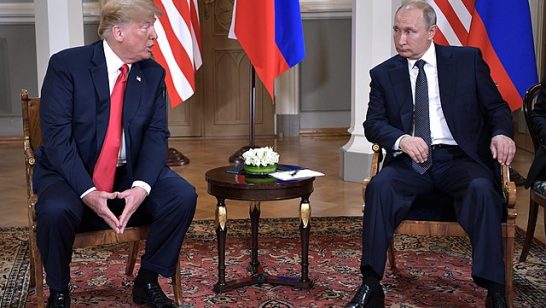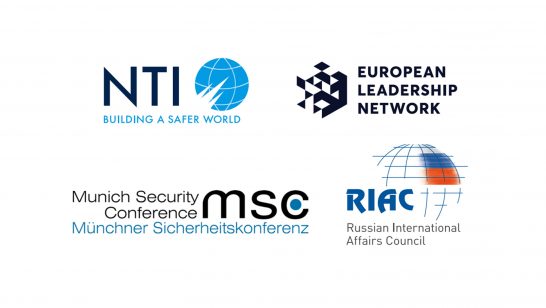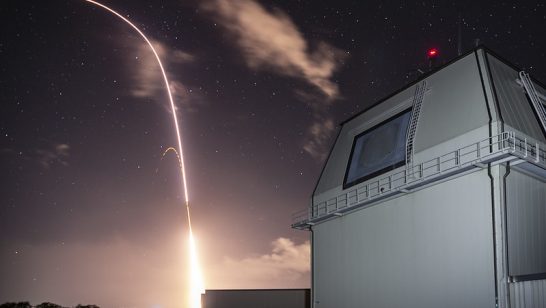
Since the Strategic Arms Limitations Talks (SALT) initiated fifty years ago, the United States and Russia have relied on verifiable nuclear arms control to constrain their competition in nuclear arms. The most recent of these agreements – the New Strategic Arms Reductions Treaty (New START) entered into force on February 5, 2011. The Treaty limits the United States and Russia to a total of 1,550 deployed nuclear warheads and 700 deployed intercontinental ballistic missiles (ICBMs), submarine-launched ballistic missiles (SLBMs), and heavy bombers equipped for nuclear armaments. In addition to establishing the lowest level of U.S. and Russian deployed nuclear armaments ever mandated by a treaty, the agreement includes robust verification mechanisms to confirm each side is complying with its terms.
New START has a duration of 10 years (until February 4, 2021) and includes a provision for extending the Treaty by executive agreement for up to five additional years (until February 4, 2026). Russia has indicated willingness to extend the Treaty, while noting some compliance concerns. The U.S. government is conducting a policy review and has thus far not committed to extension. In his October 30, 2019 nomination hearing for the position of U.S. Ambassador to Russia, Deputy Secretary of State John Sullivan pointed to the need to discuss Russia’s strategic weapons systems “that they would view as not covered by New START,” and that the U.S. position should be to engage immediately with the Russians on not just the terms of extension but also on these new weapons systems. Russia subsequently clarified that the new Sarmat ICBM and Avangard hypersonic vehicles deployed on ICBMs would indeed be covered by New START when deployed. With this significant Russian clarification about its new strategic systems, and the departure from the administration of some its most vocal critics of extension — could the prospects for New START extension be improving?
Why it makes sense to extend New START
From a U.S. perspective, the case for extending New START is straight forward: It provides limits on Russian strategic nuclear forces, strict verification, and predictability. Without it, there would be no constraints or verification on Russia’s nuclear forces. The case is equally valid from Russia’s perspective. Both countries are complying with New START and both have met the central limits as they were required to have done by February 5, 2018.
New START contains robust and intrusive verification and transparency measures. These include up to 18 on-site inspections in each country annually, as well as exhibitions of nuclear weapons systems, and data exchanges and notifications regarding the number, location, status and movements of strategic offensive arms and facilities covered by the Treaty. As of August 2019, the U.S. and Russia have exchanged approximately 18,500 notifications and U.S. inspectors have conducted more than 150 on-site inspections (18 per year) in Russia. These verification and transparency measures deter cheating and remove uncertainties that drive both sides to “worst case” military planning.
What about the new Russian weapon systems?
A key issue in the debate about New START extension relates to the new nuclear weapon systems President Putin has discussed in the past few years, some of which are closer to deployment than others. The most effective means to address those Russian strategic systems likely to be deployed in the next six years is to extend New START. Mark Melamed and I concluded in a recent NTI report, Russia’s New Nuclear Weapon Delivery Systems: Implications for New START, Future Arms Control, and Strategic Stability, that the two strategic systems Russia is most likely to be able to deploy before 2026 (the timeframe of an extended New START Treaty) — the Sarmat heavy ICBM and the Avangard hypersonic vehicle deployed on Russian ICBMs — will, according to its definitions, be accountable under the Treaty. Just last month, Russian Foreign Minister Lavrov and Vladimir Leontiev, the Russian Commissioner to the Bilateral Consultative Commission (BCC), the Treaty’s implementing body, stated publicly that both of these systems would in fact be covered by the Treaty. This is a significant clarification from Russia that should give the United States confidence that these new systems will not run free of the Treaty’s limits and verification provisions. Moreover, Russia is required by the Treaty to exhibit these new systems, allowing U.S. on-site inspectors to observe and confirm their distinguishing features for the purposes of verification. Without the Treaty, the United States would not get to inspect them. It was precisely this Treaty requirement that resulted in the exhibition of the Avangard system for U.S. inspectors as reported by the Tass News Agency last week. Under the Treaty, a similar exhibition of the Sarmat ICBM will be required before Russia may deploy it.
As Russia’s position on these two systems now seems clear, there should be no objection to codifying, in the context of an agreement on an extension if not before, that Sarmat and Avangard will be subject to the Treaty — a significant accomplishment for the Trump administration, building on the original agreement.
Regarding the other strategic systems Russia is pursuing, Jill Hruby, NTI’s inaugural Sam Nunn Distinguished Fellow and a former director of Sandia National Laboratories, assessed in a recent report, Russia’s New Nuclear Weapon Delivery Systems: An Open-Source Technical Review, that they are less mature in development, and therefore not likely to be deployed during the lifetime of even an extended New START. One is the Poseidon strategic range nuclear powered nuclear torpedo, the other is the Burevestnik nuclear powered air-launched strategic range cruise missile.
Neither of these systems fits the definition of the types of strategic offensive arms that are covered under the Treaty. However, the Treaty includes a provision stating that a party can raise in the BCC questions about the emergence of a “new kind” of strategic offensive arm. The United States can use this forum to discuss these systems and make the case that the Treaty should apply to them in the event that either is deployed while the Treaty remains in force. The United States could go further and seek to get Russia to agree in principle now that if these systems are deployed while New START is in force, they will discuss and agree on how to include them under the Treaty’s limits and verification provisions. That said, given the state of development of these two systems, there is ample time to address them, and they are certainly not a compelling reason to allow the Treaty to lapse in 2021.
What about negotiating a new treaty instead?
President Trump has expressed an interest in negotiating a new agreement with Russia, and in bringing China into negotiations. While laudable, these goals cannot be achieved before New START expires.
Future negotiations and agreements with Russia are likely to be much more complex than New START. They will need to address new systems and technologies, and additional classes of weapons. There simply isn’t time to develop a detailed U.S. negotiating position, negotiate one or more agreements with Russia, and get them ratified before New START lapses in February 2021. Moreover, with the United States and Russia still holding over 90% of the world’s nuclear weapons, China has made clear it won’t join nuclear reduction talks anytime soon.
More realistic in the near term is to continue efforts bilaterally and within the P-5 context to engage China in discussions of strategic stability, and to encourage enhanced transparency about its nuclear policies, doctrine and posture and plans. We should be aiming to bring all of the P-5 into the nuclear reductions process, consistent with our collective obligation under the Nuclear Non-Proliferation Treaty, but this will take time, and realistically will need to be preceded by greater progress on reductions by the United States and Russia.
Extension of New START is a win for US and Euro-Atlantic security
So long as Russia continues to comply with New START, it is in the interest of the United States and its allies to maintain the Treaty’s limits, verification, and predictability. The alternative to extension is no limits, no verification, and no transparency. It would be reckless to forego the benefits of New START for U.S. and Euro-Atlantic security, when as a practical matter there is nothing more effective that could be negotiated and put in place before it expires on February 4, 2021.
All countries in the Euro-Atlantic space have a stake in this matter, and some ability to affect it by making their views known to the Russian and American presidents. The presidents need to hear from their advisors and from world leaders that the extension of New START is the best policy course. It would be a demonstration of leadership that would be broadly welcomed on a bipartisan basis in the United States and by the international community. Taking this step before the 2020 Nonproliferation Treaty Review Conference would maximize global attention and reassure the world that the United States and Russia have not lost their will when it comes to reducing nuclear risks.
The opinions articulated above represent the views of the author, and do not necessarily reflect the position of the European Leadership Network (ELN) or any of the ELN’s members. The ELN’s aim is to encourage debates that will help develop Europe’s capacity to address pressing foreign, defence, and security challenges.



